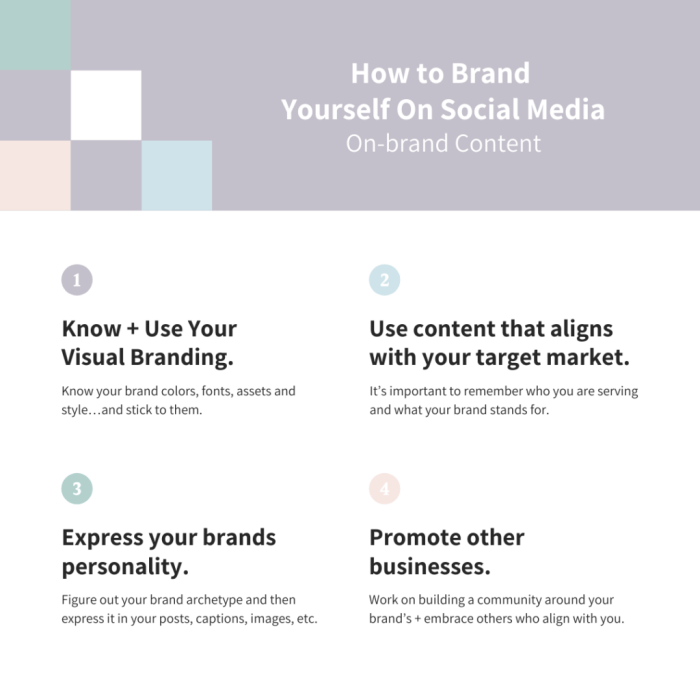Creating On-Brand Social Media Content takes center stage, inviting you into a world of creativity and strategy. Get ready to dive into the art of crafting content that speaks your brand’s language.
Define On-Brand Social Media Content

On-brand social media content refers to content that aligns with a brand’s identity, values, and messaging. It includes visuals, captions, and overall tone that accurately represent the brand to its target audience.Maintaining brand consistency in social media posts is crucial as it helps in creating a recognizable and memorable brand image. Consistent branding across all platforms ensures that the audience can easily identify and connect with the brand, leading to increased brand loyalty and trust.
Importance of Maintaining Brand Consistency
Consistency in social media content helps in building brand recognition and credibility. By using consistent colors, fonts, and messaging, a brand can establish a strong identity that resonates with its audience. This leads to increased brand recall and loyalty among customers.
- Posting content that reflects the brand’s values and personality
- Using consistent visual elements such as logos, colors, and design style
- Ensuring that the tone of voice in captions and copy aligns with the brand’s messaging
Examples of On-Brand vs Off-Brand Content
- On-Brand Content: A clothing brand consistently uses a specific color palette and design style in all their social media posts, reflecting their brand identity.
- Off-Brand Content: The same clothing brand suddenly switches to using bright neon colors and edgy graphics, which does not align with their usual aesthetic and confuses their audience.
- On-Brand Content: A wellness brand maintains a calm and soothing tone in their captions, which resonates with their target audience seeking relaxation and self-care.
- Off-Brand Content: The wellness brand starts using slang and informal language in their posts, deviating from their usual brand voice and alienating their audience.
Research and Understand Your Audience
Understanding your audience is key to creating on-brand social media content that resonates with them on a personal level. By knowing who your target audience is, you can tailor your content to their preferences, interests, and behaviors, ultimately increasing engagement and brand loyalty.
Methods to Research Audience Demographics, Interests, and Behaviors
Researching audience demographics, interests, and behaviors can be done through various methods such as:
- Conducting surveys and polls on social media platforms to gather direct feedback from your audience.
- Utilizing analytics tools to track demographic data, engagement metrics, and content performance.
- Monitoring social media conversations and interactions to understand what topics resonate with your audience.
- Creating buyer personas based on research and data to represent different segments of your audience.
How Audience Insights Guide Content Creation Decisions
Audience insights play a crucial role in guiding content creation decisions by:
- Helping you create content that is relevant and valuable to your audience’s interests and preferences.
- Informing the tone, language, and style of your content to resonate with your audience on a deeper level.
- Guiding content distribution strategies to reach the right audience at the right time with the right message.
- Allowing you to adapt and evolve your content strategy based on audience feedback and behavior patterns.
Establish Brand Guidelines: Creating On-Brand Social Media Content

Developing brand guidelines for social media content involves creating a set of rules and standards that dictate how your brand should be presented online. This ensures that all content shared across different platforms aligns with your brand identity and resonates with your target audience.
Elements of Brand Guidelines
Brand guidelines typically include elements such as colors, typography, tone of voice, style of imagery, logo usage, and overall brand messaging. These elements help maintain a consistent brand image and create a cohesive brand experience for your audience.
- Colors: Specify the primary and secondary colors that represent your brand. This ensures that all visuals remain consistent and recognizable.
- Typography: Define the fonts and text styles to be used in your content, maintaining readability and brand consistency.
- Tone of Voice: Establish the language and communication style that best reflects your brand personality, ensuring a consistent voice across all platforms.
- Style of Imagery: Artikel the types of images, graphics, and videos that align with your brand aesthetic, creating a unified visual identity.
- Logo Usage: Provide guidelines on how to use your logo, including size, placement, and color variations, to maintain brand recognition.
- Brand Messaging: Define key messages, taglines, and brand values that should be consistently communicated to your audience.
Ensuring Consistency Across Platforms
Brand guidelines play a crucial role in ensuring consistency across different social media platforms. By adhering to these guidelines, you can maintain a cohesive brand image and avoid confusion among your audience. Consistent branding builds trust and loyalty, making your brand more memorable and recognizable in a crowded digital landscape.
Content Creation Strategies
To align your content with brand values and messaging, it’s essential to first have a clear understanding of what your brand stands for. Ensure that every piece of content you create reflects these values and communicates your brand’s message effectively.
Importance of Storytelling
Storytelling plays a crucial role in creating engaging on-brand content. By weaving narratives into your posts, you can connect with your audience on a deeper level and evoke emotions that resonate with your brand. People remember stories more than facts, so incorporating storytelling into your content can help make your brand more memorable and relatable.
- Use real-life examples or customer testimonials to showcase how your brand has made a positive impact.
- Create a consistent brand voice and tone that aligns with the stories you tell, reinforcing your brand identity.
- Utilize visuals such as videos or images to enhance the storytelling experience and captivate your audience.
Examples of Successful Campaigns
One great example of a successful social media campaign that effectively reflected brand identity is Coca-Cola’s “Share a Coke” campaign. By personalizing their bottles with popular names, the brand encouraged customers to share their unique experiences with Coca-Cola, fostering a sense of connection and community. This campaign not only aligned with Coca-Cola’s values of happiness and togetherness but also generated widespread engagement and brand loyalty.
Remember, consistency is key when creating on-brand social media content. Stay true to your brand values, incorporate storytelling, and draw inspiration from successful campaigns to create content that resonates with your audience.
Visual Branding
Visual elements play a crucial role in creating on-brand social media content as they help in establishing a strong brand identity and enhancing brand recognition. By incorporating branded graphics, images, and videos into your content, you can effectively communicate your brand’s values, personality, and messaging to your audience.
Importance of Visual Consistency, Creating On-Brand Social Media Content
Maintaining visual consistency across different types of social media content is essential for building brand credibility and loyalty. Consistent use of colors, fonts, logos, and design elements helps in creating a cohesive brand image that is easily recognizable by your audience.
- Use branded colors and fonts consistently across all your social media posts to reinforce your brand identity.
- Include your logo in all your visual content to increase brand recall and awareness.
- Create templates for graphics and images that align with your brand’s aesthetic to ensure visual consistency.
- Choose high-quality images and videos that reflect your brand’s values and resonate with your target audience.
- Experiment with different visual formats, such as infographics, carousel posts, and GIFs, to keep your content engaging and diverse while maintaining visual consistency.